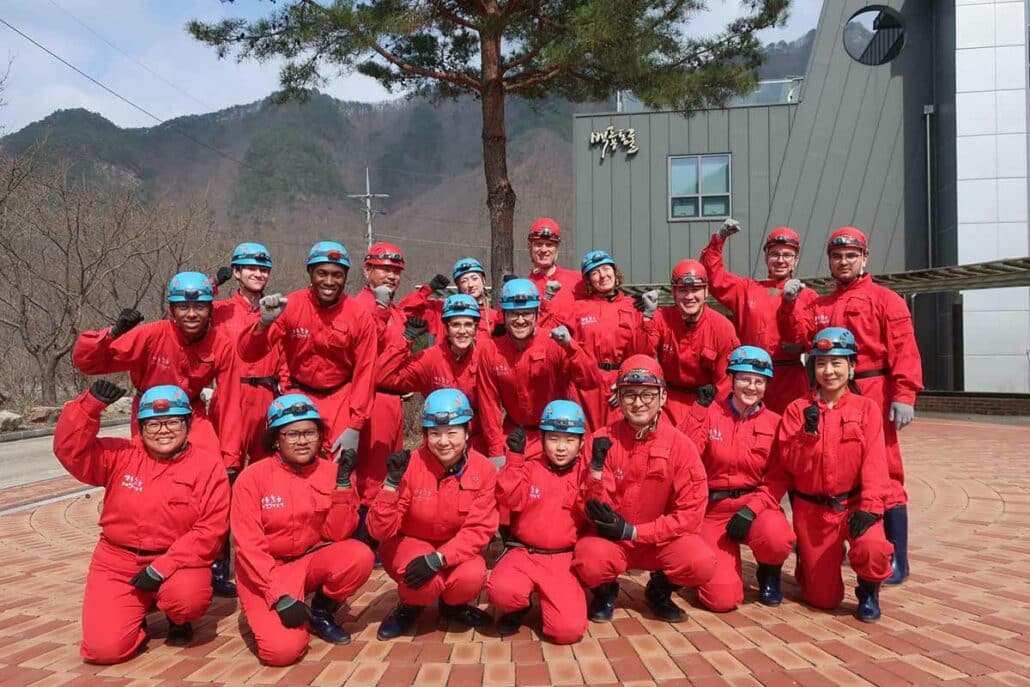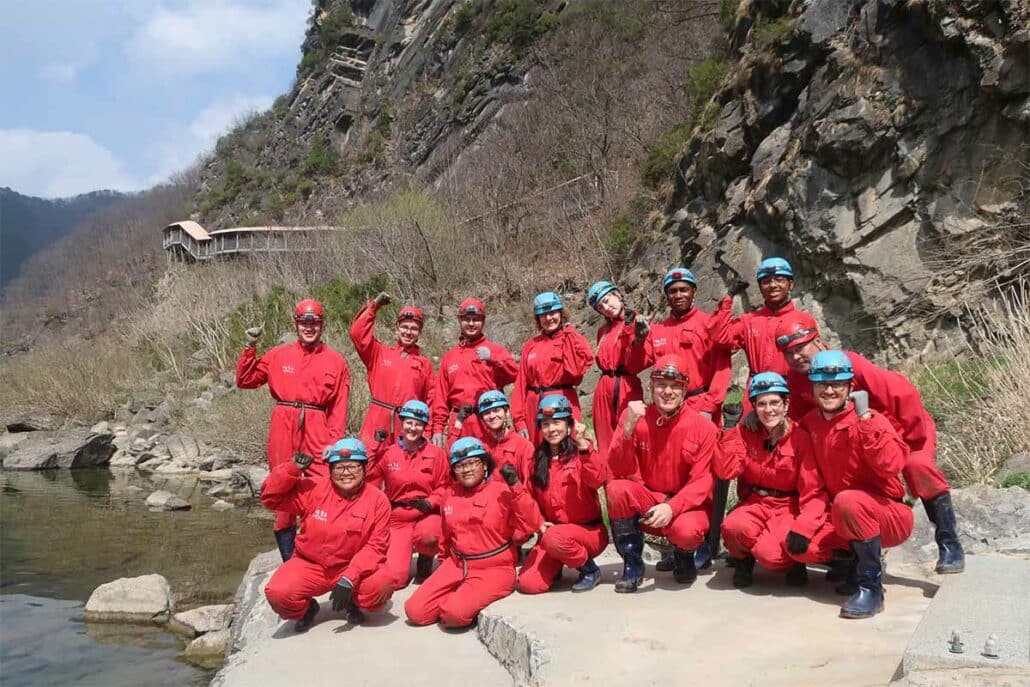The Pyeongchang region has beautiful nature, sprawling rivers, and tall mountains. However, this beauty continues inside of these mountains as well, with a great example being the Baekryong cave. This cave is also known as the White Dragon cave. It’s an ancient cave that was discovered in 1976. The cave was of course known for a much longer time and also used by the local population. But it was during this time when a young boy discovered that the cave was actually much bigger than initially thought!
Since then the cave has been classified as a natural monument but it opened to the public in 2010. This allows for people to under guidance explore the cave and get to learn about its rich history.
The adventure caving starts off with having to switch into a different outfit. You have to wear a red suit, which somewhat resembles the soldiers from the Korean show Squid Game. This alongside a helmet with headlamp and a pair of tall boots. The rest of your belongings you have to leave in a locker, including your phone. It’s not allowed to take pictures inside the cave, only the tour guide can do this. This is for preservation reasons. Once this is done we depart on a short boat trip in order to reach the cave. There is a walkway that connects to the cave as well. They however had to shut this down. This is because they realised soon after the construction of it that rocks would fall from above, making it unsafe to use. So as of now, the only way to reach the cave is by boat.
After a short boat ride we arrived at the entrance of the cave. Here you get to learn more about the cave. There is a map that showcases the layout and the guide will explain the story about how the cave got discovered by the young boy. This same young boy still lives in the nearby village, although he is currently an old man as it’s been many years since that discovery. The cave maintains a stable temperature all year round, which makes it cool during the summer and warm during the winter. Because of this it was used a lot by the locals. The entrance to the cave is also pretty small and hidden away. Because of this it was also used by the locals to hide during times of war and unrest.
The little boy who discovered the cave to be bigger used the cave as his playing area together with his friends. Sometimes they would even sleep there. It was during one of these moments when the little boy noticed that the bats would fly off somewhere but he couldn’t see where. He figured out the bats were going through a small opening deeper into the cave. After this discovery they started breaking open the back wall of the cave and discovered that it was much bigger than originally thought.
After turning on the headlamps, we headed off into the cave. The moment you enter you are greeted with an ondol, made a long time ago by the locals. An ondol is an ancient traditional Korean heating system that’s still used everywhere today in Korea. How this used to work in the past is that people would make a fire, they would then have the hot air and smoke travel below the floor before going out into the air. This would heat up the floor, making it nice and comfortable. Moving on further down the cave there is a thermometer,, showing that it was a cool 5 degrees celsius in the cave. This was pretty cold, but it didn’t take long at all to adjust to the temperature and it was actually rather pleasant.
The cave itself is very pretty, there are plenty of natural formations such as stalagmites, stalactites, and other beautiful dripstone formations. It also didn’t take too long before we encountered our first bats. They are very small so they can be a bit difficult to spot and see, especially since it’s very dark in the cave. So if you’re not looking directly at them, you’ll most likely miss them. There were a couple of bats hanging in some small corners and on the roof. We tried to move by them as quietly as possible to not disturb their sleep. The cave also started showing more narrow passageways, meaning we had to crouch down a bit to navigate our way through. Along the way we also came by a pool of water in which some small shrimps live. They managed to get there during the times when the cave was filled with water. As the water slowly disappeared the shrimps stayed in the remaining pools. Because there’s no shrimp predators in the cave they are also able to live for a long time. Soon after we find ourselves at the “end” of the cave. Or at least, what originally was assumed to be the end until they discovered more. Here we get to go onto our belly to crawl through a tiny hole into the next part of the cave.
The cave keeps on going, with more and more gorgeous rock formations, narrow passageways, and crawling sections. There are several large chambers as well, allowing you to easily look around at all the formations. Soon we take a short stop where the guide explains more about the rocks, what materials they are, and how the cave was formed. Over a very long period of time, rainwater would slowly make its way into the mountain, carving away the rocks and creating the cave. The rocks are eroded pretty easily which the guide demonstrates by taking a piece of stone from the cave and dripping a little bit of acid on it. Instantly the part where the acid hits the rock will start sizzling and bubbling a little bit, showing how fast it can erode. After this we continue caving our way towards the end.
Once reaching the end of the cave, we find ourselves in a large chamber with very large dripstone formations, where we all get to sit down. We are then instructed to turn off our headlamps, this is in order to experience total darkness. The moment everyone’s headlamp is off all you will see is darkness. No matter how close you hold your hand to your face, you won’t see it, even after several minutes when your eyes adjust to the darkness, you still don’t see a single thing. It really is a unique experience. At this point the guide turns on several lamps placed throughout the chamber. These lights illuminate the dripstone formations and play with shadows, creating beautiful and unique images such as an elephant, a skull, and more. In the chamber you can also see some of the holes through which the rainwater would flow, creating the cave. As well as black spots on the roof and floor, which are the places where bats would stay. Now it’s time to turn around again and make our way back through the entire cave again. Even though we just went through all of it, doing it the other way around makes it feel like a whole new cave again. After a while we finally reached the entrance again with the Ondol. After a long but very fun cave adventure we finally see the light of day again. We take one last group picture before we get on the boat again.
This caving adventure is truly a one of a kind experience in Korea. Most caves are very “organized” in a way where you simply walk through man made paths. With the Baekryong cave you truly get to experience adventure caving in Korea by crawling through narrow passageways, interacting with the dripstone. This is the only cave in Korea in which such a thing is possible. This makes it a must do adventure experience within Pyeongchang for when you are in Korea.















